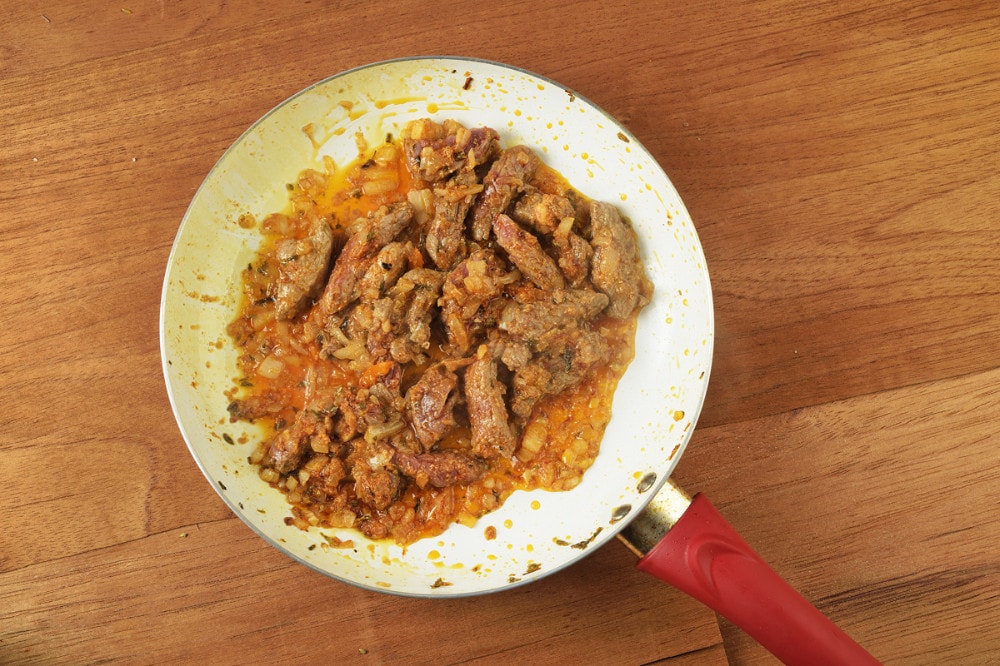
Few dishes in Peruvian gastronomy are more Andean than olluco con carne (also called olluquito con carne). Julienned olluco tubers cooked with juicy strips of meat, seasoned with the spicy Peruvian chilli pepper duo of ají amarillo and ají panca, accompanied with a generous serving of white rice and some sweet potato slices. Super quick and easy to make, the dish also needs very few ingredients to be delicious. And this explains why this dish is so ubiquitous across the Peruvian territory.
Olluco: an unsung hero hailing from the Andean highlands
The base of this dish is julienned olluco tubers. Ullucus tuberosus is a tuber native from the Andes where it has been cultivated for at least 4000 years. Unlike its cousin, the potato, this equally nutritional tuber is rarely cultivated outside the Andean region due to its very specific climate requirements. It’s usually yellow, though it can also be purple or orange on the outside. Also known as papa lisa or simply lisa, it’s consumed in soups, stews and of course this recipe, where it is the main ingredient.
Olluco is much less starchy than the potato, and it has a very palatable, soft texture. This is also why it can’t be used for fries. The texture won’t hold. For soups and stews, however, they’re perfect because they cook quickly and add a lot of flavor. In terms of nutritional properties, it is also a winner: it has high levels of vitamin C and iron.

Charqui: dried salted llama meat
Today we’re preparing the olluco stew with strips of beef, but we have to mention the dried llama meat known as charqui here, since olluquito is very frequently made with charqui rather than beef. Remember that this dish goes back hundreds of years, from before the Spanish conquistadors arrived, before cows were introduced to the Andes region. The Incas consumed llama, alpaca and guinea pig meats. One way of preserving these meats was by salt curing them. Charqui is salt-cured strips of llama or alpaca meat.
If you can find charqui and want to use it in this recipe, don’t forget to soak it overnight in order to remove the salt. Fun fact: the English term “jerky” in beef jerky actually comes from the Quechua word charqui. A testament to how words and recipes travel through time and space.

Vegetarian and low-calorie variations of olluco
The meat can easily be replaced with cubes of chicken breast, and for a vegan version, omit the meat altogether, or use soy meat. Tip for a lower calorie version: increase the amount of olluco stew and take out the rice and sweet potato entirely. Olluco consists of 80% water and has a fairly low amount of calories, so it’ll fill you up but not fill you out!
We hope this little bit of history has given you an appetite, because it’s time to get out the kitchen utensils and prepare this indigenous Andean delicacy ourselves!
Olluco Con Carne: Traditional Main Course
Ingredients
- 2 tablespoons vegetable or olive oil
- 1 onion finely chopped
- 2 tablespoons garlic paste
- 1 tablespoon ají panca chilli pepper paste
- ½ teaspoon cumin
- 1 teaspoon dried oregano
- 1 pound sirloin steak cut into strips (or 1 pound charqui, soaked overnight)
- 1 fresh ají amarillo chilli pepper veins and seeds removed, chopped into strips
- 2.2 pounds ollucos julienned into thin strips
- 2 large sweet potatoes peeled and boiled
- 1 pound long-grain white rice boiled
- 2 tablespoons fresh parsley chopped
- Salt and pepper to taste
Instructions
- Heat the oil and lightly fry the onion, garlic, ají panca chilli pepper, cumin and oregano over a medium heat for three minutes. Add the ají amarillo chilli pepper.
- Cut meat into strips
- Add the beef strips
- Fry until golden
- Add the julienned olluco, mix well and add a little bit of salt.
- Cook for 20 minutes, stirring continuously.
- Place a generous portion of the olluco stew on a plate, topped with some chopped parsley, and serve with a few slices of sweet potato and a portion of rice. Enjoy!
Nutrition


Peruvian foodie. I’ve been writing about the food of Peru for over 10 years. Read more about the Eat Peru team here









Leave a Reply